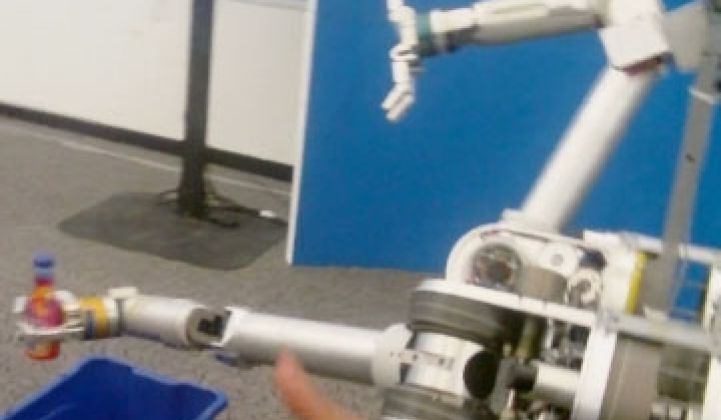Intel may have come up with a way to solve one of the most pressing problems with home energy management consoles, and the solution harks back to the early '80s.
The company has developed a home energy management console that comes with 1) a household clock and 2) an answering machine that stores and plays back video messages. The console also sports an iPhone-like interface with apps for checking daily power consumption, historical power consumption and other data. Nonetheless, the answering machine, and to some degree the clock (with the hours corresponding to peak power periods painted in red), represent the real breakthroughs.
Why? Home energy management companies admit that it has been tough to get consumers to interact with their consoles after the initial thrill wears off. By integrating an answering machine, consumers will inadvertently have to come in contact with their energy consumption all the time.
"We realize energy can get boring," said Mary Murphy-Hoye at Intel Labs. "We've got to give people reasons to interact with it."
As part of its push into energy, Intel will make 1,000 of the units by the end of the year and conduct trials with various utilities. The company will then license the reference design -- probably for free -- to retail manufacturers. A contact manufacturer has already been enlisted to take orders (see video).
While Intel remains known primarily for its chip expertise, the company has over the last several years placed an increasing emphasis on human factors and interfaces. What is the point of improving PC performance, after all, if humans can't figure out how to take advantage of it? To that end, the company promoted Genevieve Bell, an anthropologist who has been at Intel for years, to the position of Intel Fellow. The 'Fellow' designation is given only to a select few scientists at the company, and it's a good bet that Bell, who has studied everything from where Indian families put their PCs in their homes to how toddlers play with cell phones, is the first social scientist to receive the honor.
Electronics manufacturers and utilities will have to move beyond simply appealing to pocketbooks to get consumers to adopt energy efficiency technologies, Bell said in an interview. Convenience, as with the answering machine example, can help. So can social pressures. In some old buildings in China, elderly ladies are given the task of keeping an eye on utility meters. If they detect that a particular family is using more than their fair share, they make a point of berating the energy hogs. This form of social regulation helps make conservation a part of daily life.
"In many parts of the world, energy consumption is more visible," she said.
In Europe and Israel, part of the success of recycling programs can be traced to the fact that the recycling centers are often located in the centers of cities, making them more visible. In Australia, some jurisdictions have increased the size of the recycling bin and reduced the size of the garbage bin in order to encourage recycling.
In the U.S., conservation and consumption are mostly invisible, but visibility could be increased, and some examples of this approach do exist. "The visibility of the Prius had a social cachet," she said. Companies like OPower have also used peer pressure to encourage conservation.
So what else does Intel have? Check out this video of a recycling robot. It can detect shapes in the vicinity and then use the information it gleans to take action. In this demo, it is recycling. In real life, robots like this might be used for elder care.
The company additionally showed off piezoelectric devices, which convert movement and kinetic energy into electricity. The company is also working on ways to harvest heat escaping from your body to harvest milliwatts. The difficulty is that the amounts of power harvested remain relatively low, said Intel Labs researchers John Agosto.
Intel also demoed smart charging applications and energy management systems for commercial buildings. While interesting, the applications didn't seem that different from similar ones from Cisco, Johnson Controls and others.
And finally, check out this video of a ribbon strip for connecting boards inside computers. Replacing wire input/output channels with this device can potentially crank down power usage in servers and PCs. Intel is also developing LightPeak, a low-power optical connection that can connect two different computers. So the company plans to use ribbon connecting components on the inside of boxes, and optical technology (a concept that's been in the works since 2000) for connecting boxes. Conceivably, these sort of components could also be used to boost the efficiency of smart grid equipment, electric cars, wind turbines and pretty much anything else with chips in it.
Let the IT colonization begin.



